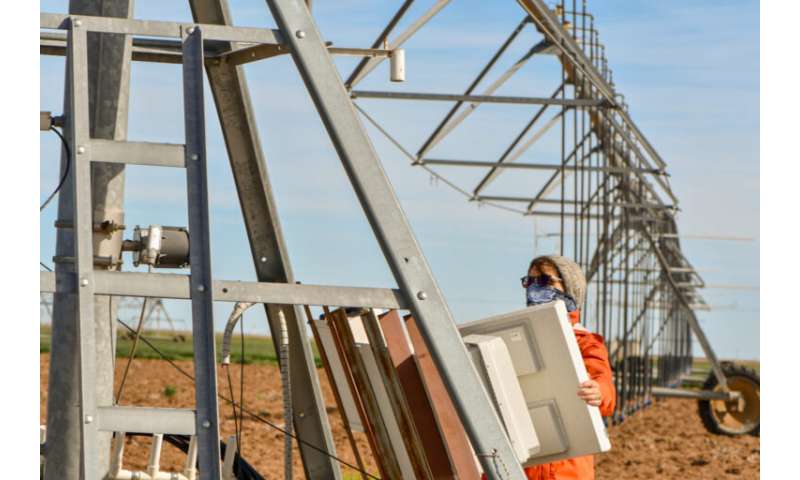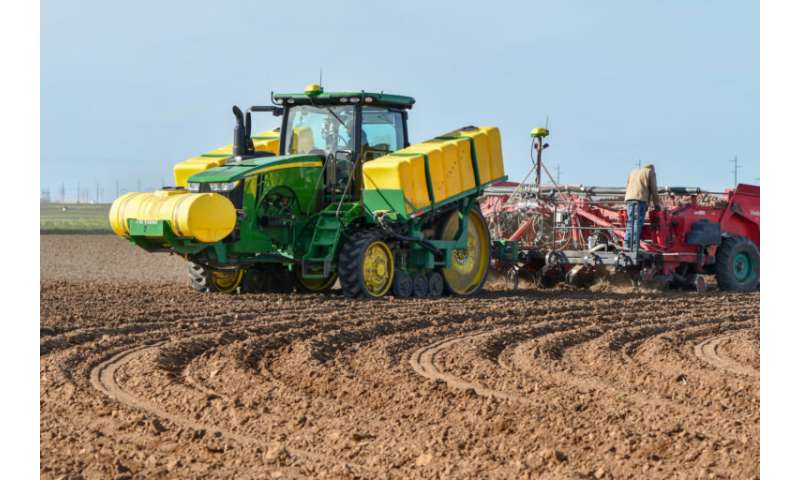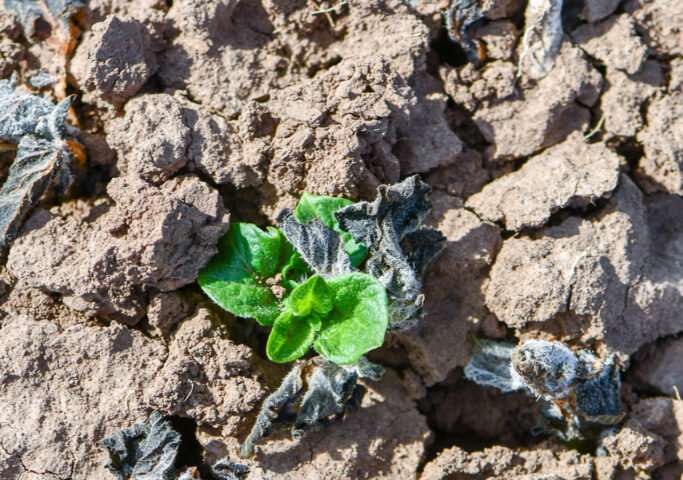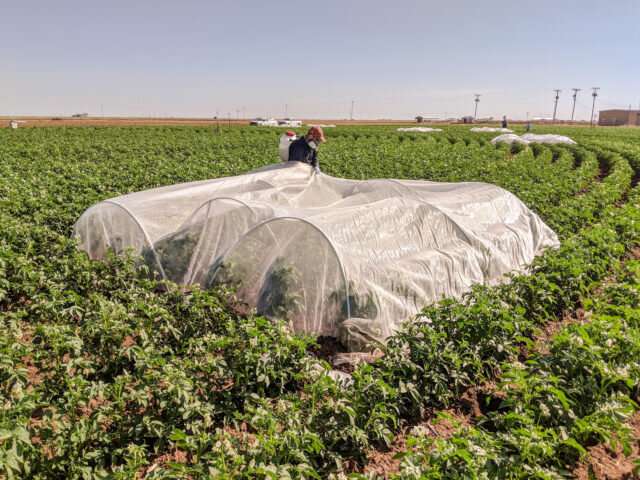
Federal and state researchers are studying irrigation scheduling and a potential for water savings in potato plants at the Conservation and Production Research Laboratory at Bushland.
This year they called upon an ally in the potato industry to help them when the COVID-19 pandemic threatened the planting of the 2020 potato plots due to social distancing rules.
The three-year project, supported by the Texas Department of Agriculture Specialty Crop Block Grant program, is a collaboration between Susan O'Shaughnessy, Ph.D., U.S. Department of Agriculture-Agricultural Research Service, ARS, agricultural engineer-irrigation automation, and Charlie Rush, Ph.D., Texas A&M AgriLife Research plant pathologist.
The project has two purposes: O'Shaughnessy is analyzing the ability of sensors attached to an irrigation system to determine when the crop needs a drink using the plant's temperature as a guide. The variable rate wireless irrigation scheduling system would schedule water application in relation to the temperature of the plant.
Rush, on the other hand, sees himself as a "plant doctor" who wants to know if that plant's temperature is an indication of disease or illness, much like a fever in a human.
Bringing in the big equipment
In the past two years, a 6-acre plot of potatoes has been planted with a four-row planter that requires multiple people to work closely together, First, they must unload totes of potatoes into the planter and then spend three days riding side-by-side feeding the potatoes into the planter.
Rush said it could have been done again this way in 2020, but only if they could have obtained enough COVID-19 protective equipment for all the workers.

"We had a situation where ARS had rules handed down that made it difficult to continue this project," he said. "We didn't want to lose an entire year's worth of research; but we weren't about to put our people at risk. And if we had waited and planted later in the season it would not have been an apples-to-apples comparison from one year to the next."
Rush's longtime collaborators from the potato industry, CSS Farms, helped them avoid the COVID-19 issues and loaned them the use of their industrial-sized planting equipment. It took a little over two hours to plant the entire research plot.
Rush and AgriLife Research have been at the forefront of the battle against zebra chip of potato, a disease that once almost destroyed the potato industry in Texas. The potato psyllid transmits a bacterium, which causes a disease called zebra chip.
"We have been working with Dr. Rush and his research team for more than 10 years on the potato psyllids and the zebra chip disease," said John Scheuring with CSS Farms in Dalhart. "He has been a tremendous help to us and the industry, and we owed him and his program this. Also, we will benefit from their ongoing research, so it was a win-win situation for us."
Rush said it truly is a win-win-win situation for the researchers, growers and consumers. CSS Farms grow potatoes for Frito Lay, and "this is all based on producing the best quality crop and maximizing the water we use so we can produce the biggest, healthiest crop with the least amount of water and not waste it by putting it on diseased plants."
Potato research aimed at water efficiency
O'Shaughnessy's research will help potato growers be more efficient with their water inputs. She is managing chipping potatoes with canopy temperature measurements and soil water sensors to determine how to apply the right amount of water at the right time.
"Potatoes are very sensitive to both over irrigation and drought conditions," she said. "We want to optimize the amount of water we put onto the potatoes; preventing over irrigation as well as under irrigation."

O'Shaughnessy said in the first year, they were investigating the right threshold levels to signal an irrigation. In the second year, they found using the canopy temperature sensors alone allowed them to produce potatoes at the same yields as manual irrigation scheduling using weekly neutron probe measurements.
"With the canopy temperature measurements, we can look at crop water stress as the pivot moves across the field. So, we are using that information and the soil water sensing to develop dynamic prescription maps with our variable rate irrigation system. What we hope to do is provide farmers with an easier way to manage potato fields, especially in fields with variable soil conditions."
She said she hasn't seen as much soil water savings as she would have liked to, so this year her team will look at the triggers they are using for irrigation scheduling with the soil water sensors.
"We are also going to look at diseased plots and look at UAV images to indicate when the plant is diseased and hopefully work with canopy temperature measurements and soil water sensors to improve upon their water savings," O'Shaughnessy said.
The plant doctor is in
Rush said water savings is where his interest lies. Watering a sick plant could be a waste of water.
"The idea that a plant only gets hot when it is thirsty is incorrect from my point of view," he said. "I'm a plant doctor, so I'm also interested in the plant's temperature. A plant getting hot can also indicate a diseased root system or some other physiological issue that's impacting the health of the plant. Just like with people, a fever indicates something else in the body is wrong, it's not functioning right."
Rush said he has long hypothesized disease will impact the plant's water-use efficiency, and the plant will be hot if its temperature is measured with a thermometer.

"If you were just assuming it was a healthy plant, then you would just put water on it," he said. "But if it is really a diseased plant, then putting water on it is not going to help at all. Matter of fact, it may make the disease worse."
He said so far, his team's results are pretty much as expected. They set up tents in the field and infest the potatoes beneath them with potato psyllids carrying the zebra chip disease bacterium. The psyllids remain for a week, giving them time to infect the plants. Then the remote sensing is used to record the color and temperature of the plants through the rest of the growing season.
"In about three weeks, the plants start getting sick. They start showing fever, but not because they are thirsty, and their ability to utilize any water applied is impacted," Rush said. "We think this technology will be useful in the future, but we will have to have control measures in the field."
The control measure will deal with color, he said. Plants don't typically turn yellow when they are just thirsty. Plants do turn yellow if they are sick, though.
"So, if you use the thermal sensors in addition to sensors that can detect the color of the plants and can monitor the beginning of that shift from a healthy dark green to a sick chlorotic yellow, then you can put that together with the temperature. If you have a plant that is dark green and turning hot, it needs water. The plant that is hot and turning yellow would be sick and doesn't need more water."
A variable-rate irrigation system designed to water based on heat signatures would also need to be able to compensate for disease, insect damage or anything else in the field that causes the plant to change colors.
Explore further
Citation: Potato study uses irrigation system feedback to distinguish between plant thirst and disease (2020, April 20) retrieved 20 April 2020 from https://ift.tt/3eE5NXo
This document is subject to copyright. Apart from any fair dealing for the purpose of private study or research, no part may be reproduced without the written permission. The content is provided for information purposes only.
"potato" - Google News
April 20, 2020 at 08:11PM
https://ift.tt/3eE5NXo
Potato study uses irrigation system feedback to distinguish between plant thirst and disease - Phys.org
"potato" - Google News
https://ift.tt/2rh4zOj
Shoes Man Tutorial
Pos News Update
Meme Update
Korean Entertainment News
Japan News Update
Bagikan Berita Ini














0 Response to "Potato study uses irrigation system feedback to distinguish between plant thirst and disease - Phys.org"
Posting Komentar